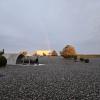TITLE: 09/11 Day Shift: 1430-2330 UTC (0730-1630 PST), all times posted in UTC
STATE of H1: Observing at 145Mpc
INCOMING OPERATOR: Tony
SHIFT SUMMARY:
Calibration Early Morning (8AM-10AM):
Lockloss during calibration with the probable reasons. Happened as soon as simulines ran an L1_SUSETMX injection. Either:
- It was the simulines measurement itself since this was recently changed, though reportedly everything about the excitations is the same
- It was the more sensitive IFO state during this measurement since we were running the cal sweep at a AS new offset (what offset).
So in short, no calibration work was done.
Squeeze Late Morning (10AM-12PM):
We got to NLN again at 17:17 UTC! Then a 6.3 EQ came though and we lost lock while the ground PEAKMON was reading 4.7 microns. We Initially thought we would make it but alas.
Sadly, no squeeze work was done either.
Earthquakey, Windstormy Quiet Noon (12-4:30PM)
After this 6.3 EQ, we were hit by two more 5.8’s from Vanuatu while wind speeds steadily went over 30mph from 19:20 UTC to 20:20 UTC. We stayed in this unstable state for about 3 hours losing lock approximately 20 times pre-DRMI. Wind peaked at 38Mph but once it went below 28ish Mph, we were able to lock, and quite quickly as well. The successful acquisition run only took 50 minutes!
As though the tree has to fall when nobody is listening, I left the room for 40 minutes for the OPS meeting and I came back to a fully automatically locked IFO in NLN. We were in OBSERVING minutes later. I guess the wind also came down by 10mph avg in that time so scientifically, it was probably that.
Initial Alignment Weirdness: Ongoing Issue
During initial alignment SRC align and only since making the SR3 move, SRM, SR2, SQUEEZE_OUT and IFO_OUT saturate at times where they are not known to do so. Looking closely at the ASC AS_A DC_SUM_OUT, this happens when the counts are sufficiently high but a glitch occurs that misaligns SRM very badly. Ryan C found a temp solution by going into IFO_NOTIFY and then pausing at PREP_FOR_SRY for a few seconds.
Sheila and I investigated very briefly and found that the ASC trigger signal malfunctions sometimes by activating when it is much lower than its threshold for activating. More investigation and monitoring to come.
Other:
IMC Gain Redistribution during LASER_NOISE_SUPPRESSION worked! I’ve unmonitored its SDF (by instruction) and we’re testing/monitoring it. SDF Screenshot attached.
LOG:
| Start Time |
System |
Name |
Location |
Lazer_Haz |
Task |
Time End |
| 23:58 |
SAF |
H1 |
LHO |
YES |
LVEA is laser HAZARD |
18:24 |
| 15:19 |
FAC |
Karen |
Optics Lab |
N |
Technical Cleaning |
16:19 |
| 17:49 |
SQZ |
Camilla |
LVEA |
YES |
Turn on hartman Wavefront Sensor chassis |
17:51 |
| 21:04 |
EE |
Marc |
MY |
N |
Part Search |
22:29 |
| 21:40 |
VAC |
Janos |
Cryo: LVEA, MX/Y, EX/Y |
N |
Cryopump Check |
23:39 |




















































